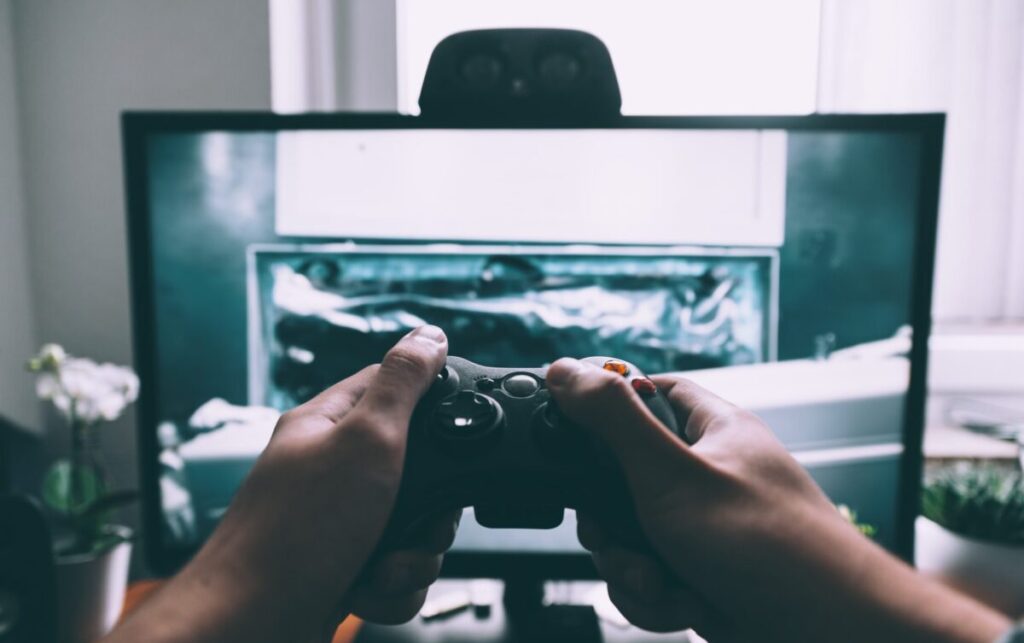
Are your kids addicted to video games?
The word “addiction” gets used a lot to describe a certain kind of focused attention on media and technology. We say we’re “addicted” to checking our email or “addicted” to watching Game of Thrones. Kids, however, might display what looks to be addictive behavior when they’re only super engaged in creating something or getting to the next level in a game.
But if you have real concerns about your kid’s behavior and notice mood changes, falling grades, mounting bills, or a lack of human interaction, you may want to talk with your pediatrician about the possibility of game addiction or the idea that another issue, such as depression, might be causing these problems.
Consider how much time you spend looking at screens, too. Make sure you’re setting a good example at home by moderating your own technology use. And it’s always a good idea to invite your child to do something together in the real world.
Do you live with a child obsessed with video games?
A kid who’d rather play Minecraft than ball?
Who would sooner build worlds in Terraria than accompany you to the neighborhood barbecue?
I took it hard, the day I finally admitted to myself that what most inspires my nine-year-old son is a video game.
Certain we were on the road to laziness, brain atrophy, and obesity, I went through a long spell of helicopter parenting: policing, nagging, and threatening.
My lowest move was to hide the ipad.
This was not a sustainable approach. It didn’t make the desire for video games go away. If anything, the deprivation increased the appetite. It made everybody feel bad.
I had to face facts: the world was against me in this fight. Laptops, ipads, ipods, smart phones, Xbox–this stuff isn’t going anywhere.
I needed a positive approach to video games, to screen time in general, a term meaning any time spent in front of a screen: games, movies, or movies of other kids playing games. The following strategies worked.
Being able to look beyond the immediate transgressions to focus on the bigger picture is an important aspect of positive parenting.
I now look at screen time as a fact of life. It doesn’t depress me that my kids like this stuff. I no longer believe that loving Minecraft means you are a lazy and dull person, irrevocably obsessed with video games and destined to suffer from nervous breakdowns or clogged arteries.
And most importantly, I don’t feel guilty about my changed beliefs.
Limits are the key. Start with your attitude: approach video games as one of many options in the vast tool bag containing cool things your kids get to do, rather than the evil monster that will take over your life.
The beast can be tamed. Here’s how.
#1 Accept that gaming is fun for your child, even if it’s not fun for you
Those of us who did not grow up with ipads, ipods, and multitudes of devices wonder why anyone would want to spend his down time in a two-dimensional world with no real plot?
Well, not a lot of us want to play tag for more than ten minutes, either.
Minecraft offers yet another opportunity to separate your experience from that of your child.
It isn’t your fault. The love of games did not come from your failure to expose them to sports or to read to them. They like what they like.
As long it’s not dangerous or illegal, it’s all alright. End of story.
#2 Decide what you can live with
Take a couple of days to study your own behavior.
Do you start slamming cabinet doors when your kid has been using a screen for more than a half hour? Do you begin to pace the halls after forty-five minutes? Look for signs of edginess, like mindless snacking.
In our house, screen time means total silence, which I love—I get things done! But after an hour, it starts feeling creepy, similar to what I feel on a gorgeous Sunday when I hear the sound of a golf tournament coming from our living room. I start imagining fat cells expanding. People on the couch begin to resemble potatoes.
If I demand an immediate cease and desist, things go downhill quickly. The kids pounce on each other. It’s as if all that stillness incubates an explosion of physicality. They have poor attitudes, back talking about dinner, negotiating everything, even what to have for snack.
This was good information. I extended screen time by a half hour and I gave fair warning. Ninety minutes. That’s what we can live with.
Soon, this developed into house policy: they get screens on Friday, Saturday, and Sunday for ninety minutes. Nothing during the week, because it’s too hard for them to go into that still, focused game mode and still keep up with the work/school routine.
Three more tips for developing your house policy:
- Both parents should be involved. If Mom is the only one who ever says “Time’s up,” she’s going to be very unpopular very fast.
- Consider not owning an Xbox or Wii. Large gaming systems are harder to manage for two reasons:
- They put you in a bigger playing field. Now you’re dealing with Call of Duty, Grand Theft Auto, Halo and Assassin’s Creed. Not having them in your house might eliminate a few haggling sessions.
- A lot of these games are violent. Since they are played on a bigger screen, with a joystick, it feels a little more edgy, more full-body. This makes the off button harder to push.
- Screen time in the morning is different from screen time in the afternoon. The research of Dr. John J. Ratey of Harvard Medical School, author of the book Spark: The Revolutionary New Science of Exercise and the Brain, and now the “Sparking Life” movement, has shown that a person of any age who exercises even a half hour in the morning is much more likely to be able to sit still and focus, and retain what he learns. Ratey’s researchis behind the idea of brain breaks in corporate offices: short periods of movement every hour shown to increase productivity and elevate mood.
#3 Decide on your approach
Now that you’ve decided it’s okay if they like something you don’t, and you know what you can live with, you need a way to look at your approach to limits. Most people will fall into one of two camps.
- The “Gaming As Dessert” approach.
This approach assumes that it’s a privilege to play games. They are a reward, maybe instead of allowance. Practice your trumpet for a half hour, earn a half hour on the ipad. Mow the lawn, you earn an hour (depending on the size of the lawn).
Some kids (and their parents) love elaborate systems like this. Similar to a star chart, grids can be made, boxes checked. Negotiators love hashing out how much screen time is earned from each chore. Consider keeping track with different colored ink for different tasks.
- The “Gaming Manifesto” approach.
This is for parents who’d rather avoid negotiations. You set up the screen time policy, maybe write it out, perhaps on a white board. Post it in the house where it can be referred to often. The advantage here is keeping it simple.
It’s unrealistic to think that the Manifesto means the end of negotiation. Your child will come to you and say, “I’m all caught up. Can I do a half hour of Terraria?” Direct his attention to the white board and say, “I’m glad you’re caught up! But remember, we don’t use screens except on weekends (or whatever your policy is).” When he asks why, the white board is there, a comforting object: “That’s our policy!”
Helpful hint: Avoid using screens as the off button.
Travel days are one thing; everybody needs some mind numbing to get through an airport wait. But the days of using the Baby Mozart DVD to grab a shower are over.
Now that they are older, appetites can build. For both of you. If you dole out screen time so you can clean the kitchen, you’ll want to clean the bathroom, too. Maybe finish that thing at work you didn’t get to last week.
Don’t be afraid to simply say, “No.” Even when it appears that there is nothing else to do, all their friends are at camp and your house feels like the most boring place in the world. It isn’t. There are toys. Books. A back yard.
Once I practiced this, I saw it really can work. I got out of the shower, scared to look, and found my kids making a bubble soup in the kitchen sink. They had wooden spoons, tongs, a spatula. They carried the whole thing outside and … I stopped watching. Maybe they poured it on my tulips and that’s why they didn’t come back. Doesn’t matter. They were industrious. Nobody got hurt. At least none of the people. Or the pets. As for the tulips… it’s still an unsolved mystery and at this point, I am content to leave it at that.
#4 Consider consequences
There will be sneaking. Here are some strategies to handle it when it happens.
- Have a fixed spot for portable gaming devices. Keep them in a specific place, a corner shelf or a large tray on the kitchen counter. This way it’s easier to see if any are missing.
- Have a consequence system set up.Discuss this when you explain the limits. Keep the consequences logical, simple, and direct. In our house, the penalty for sneaking is loss of screen time. If I walk into my daughter’s room on Saturday morning and find her in bed with ipod, I say nothing. I hold out my palm and she sets the device in it. Our limits only allow screens on weekends, so losing a day is harsh. If she does it again, that’s it for the weekend. Then we start on the following weekend.
- Never punish yourself with your consequences.If you can’t live without the hour of silence you get when your kids are playing Minecraft, make the consequence something else. No dessert. No sleepover. Make sure it is discussed clearly and ahead of time, so everyone involved knows what to expect and you aren’t tempted to dole out punishment-disguised-as-consequences in the heat of the moment.
#5 Decide on a ritual for transition time
Rarely do we power down at the office and jump back into domestic life. There is the gathering of stuff, walking to your car or the bus. The commute is part of the transition.
In the same way, our kids need a transition from the virtual world to the real world. Here are some simple steps:
- Use specific language so your kids know they are transitioning. They’ve just been killing creepers and building worlds, which can be tense work. Lighten the mood. Refer to the real world as the RW. Call them back: “You are hereby summoned to the RW! I missed you!” In a subtle way, this privileges the real world over the virtual, while also recognizing that when they are gaming, they really are somewhere else.
- Make it physical. This doesn’t have to be a mile run, or a game of soccer. How about a drink? It’s simple, free and easy. An hour on the screen without moving usually means not a single swallow of water. Consider a stretch routine. Not an hour of kid yoga, but a simple Reach for the Sky. Maybe throw in an arm stretch: right arm folds across the chest, hold for a breath, repeat with the left arm. The point is to bring awareness back to the body, reminding your child he’s a human being, in a three dimensional world. Teeth brushing might work. Face washing, anything that gets the focus back on the physical self.
#6 Counterbalance screen time with time outdoors
This tip comes directly from the research of Richard Louv, author of Last Child in the Woods: Saving Our Children From Nature-Deficit Disorder, and The Nature Principle: Reconnecting with Life in a Virtual Age.
No experience beats the outdoors for stimulating all the senses, according to Louv. Contact with nature is as vital to kids as good nutrition and adequate sleep.
I happen to agree. Even when getting my kids outside is like moving cinder blocks, once we get there, I see immediate benefits. My son is not big on team sports, but outside, especially in summer, he’s unstoppable. If I get him on a hiking trail with a creek, we don’t get past the water. Clothing? So what! He’s fully submerged, rolling around in ankle deep water. It makes for a long, soggy walk back to the car. Talk about all the senses.
The outdoors is the polar opposite of the intense, narrow, hunched-over focus of a video game. The abundant feeling of the whole body in a vast world contrasts nicely with the hand held, 2-D device. Without any lecturing or rules, nature is an invitation to be physical, human and real.
#7 Search for a gaming camp
This summer I signed my son up for Minecraft camp, through the local children’s museum. For three days, twelve kids got to play Minecraft in the same world, in the museum’s basement STEAM lab, complete with 3-D printers.
My friends thought I’d gone mad: wasn’t this exactly what you didn’t want? Your child gaming, in summer?
I saw several benefits to this camp:
- Experience in virtual reality, with strangers, in a safe, structured environment.When one of the kids used his avatar to destroy my kid’s house, he could turn around and say, “Hey! Why’d you do that?” Not possible when you’re on a server in the library with anonymous people who think it’s fun to kill you.
- Exposure to the camp leader, a twenty-something man with experience in an animation lab, working on films like How To Train Your Dragon ll,and Madagascar 3. He was as excited as the kids were about what they were learning. If my son really doesn’t find anything else he loves as much as building stuff in 2-D, maybe an animator isn’t the worst career he could end up in?
- Set gaming time.I built up the camp each time he argued for more screen time in summer: “Well, you have camp coming up.” When it was over, I still used it: “Remember, you got to play all day for three days. That was awesome, wasn’t it!”
- Finally, 3-D printers are just cool.A machine works relentlessly laying down polymer to build an object my boy designed. Something he can then hold in his hand. Something that is not a piece of paper. Astonishing.
Love this article? Receive others just like it once per week directly in your mailbox. Click here to join us… we’ll even get you started with our FREE mini-course How to Be a Positive Parent.
The 2-Minute Action Plan for Fine Parents
Here are some ideas to help you cultivate a positive approach to your child’s love of video games / screen time.
- Can you name three activates your child loves that you do not? Do any of those trigger negativity the way video games do?
- At what point does your negative reaction to screen timekick in? As soon as you see the device? With Candy Crush sound effects? What are the signs? Do you snack mindlessly? Feel crabby? Yell at the dog? Identifying your own limits can help you outline an approach you can live with.
- What kind of a planner are you? Do you like charts, details and equations? Or are you more a Big Picture person. Consider your own checking account. Do you record every purchase immediately, or do you sit down once a week and go through the records in one sitting. Do you like using markers, maps and diagrams? Will a simple white board do?
- What did you sneak as a kid? Cans of soda? A book under the blanket? Remember, just because your dominant feeling about screens is negative, that doesn’t mean you can’t somehow relate to your child’s enjoyment of it.
- How do you transition from work to home? What about your commute do you like? Do you listen to music? Do you walk? If your own transition isn’t where you want it to be, what are some actions you can take to bring you back to your physical self before you walk through the front door?
The Ongoing Action Plan for Fine Parents
- Choose one activity your child loves that you do not. Challenge yourself to write, or say, a statement about it. It might sound like this: “I am not a sports fan, but my child loves soccer. I’m willing to drive all over town to foster that love.” How willing are you to move towards that model in regards to screen time?
- Decide this week: do I want Xbox in my house? If your spouse loves the Xbox, prepare to have a heart to heart about what kind of plan you can both enforce for the kids.
- Prepare to call the family meeting where you unfold your new approach. Knowing your own trigger signs and when they kick in will help you understand what kind of plan you want propose, a Dessert approach, or a Manifesto. Be open to your child’s input; on which points are you willing to negotiate?
- Set up an easy, consistent ritualfor the end of screen time, something as simple as a drink of water, a two-minute stretch or a walk around the yard.
- Can you get your kids outside once this week? Maybe on the weekend when you have more time and some help? You’ll feel a lot better about your kids playing video games if they are also spending time in the boundless world of nature.


